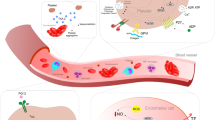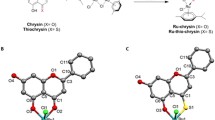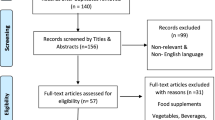Abstract
The failure of mechanisms of natural anti-coagulation either due to genetic impairment or due to severe external injuries may result in a condition called thrombosis. This is believed to be the primary cause for a variety of life-threatening conditions such as: heart attack, stroke, pulmonary embolism, thrombophlebitis, and deep venous thrombosis (DVT). The growing number of these incidents requires an alternative anti-coagulant or anti-thrombotic agent that has minimal side effects and improved efficiency. For decades, plant polyphenols, especially flavonoids, were known for their vital role in preventing various diseases such as cancer. Mitigating excessive oxidative stress caused by reactive oxygen species (ROS) with anti-oxidant-rich flavonoids may reduce the risk of hyper-activation of platelets, cardiovascular diseases (CVD), pain, and thrombosis. Furthermore, flavonoids may mitigate endothelial dysfunction (ED), which generally correlates to the development of coronary artery and vascular diseases. Flavonoids also reduce the risk of atherosclerosis and atherothrombotic disease by inhibiting excessive tissue factor (TF) availability in the endothelium. Although the role of flavonoids in CVD is widely discussed, to the best of our knowledge, their role as anti-thrombotic lead has not been discussed. This review aims to focus on the biological uses of dietary flavonoids and their role in the treatment of various coagulation disorders, and may provide some potential lead to the drug discovery process in this area.

Similar content being viewed by others
Abbreviations
- AA:
-
Arachidonic acid
- ACS:
-
Acute coronary syndrome
- aPTT:
-
Activated partial thromboplastin time
- ASA:
-
Acetylsalicylic acid
- CEP 350:
-
Centrosome-associated protein 350
- COX-1:
-
Cyclooxygenase-1
- CVD:
-
Cardiovascular diseases
- DNBS:
-
Dinitrobenzene sulfonic acid
- DVT:
-
Deep venous thrombosis
- ED:
-
Endothelial dysfunction
- HNE:
-
4-Hydroxy-2-nonenal
- MAPKs:
-
Mitogen-activated protein kinases
- NAC:
-
N-acetylcysteine
- NO:
-
Nitric oxide
- PMQ:
-
Pentamethylquercetin
- PON2:
-
Protein paraoxonase 2
- PT:
-
Prothrombin time
- ROS:
-
Reactive oxygen species
- SNI:
-
Spared nerve injury
- SOD:
-
Superoxide dismutase
- TBARS:
-
Thio-barbituric acid reactive species
- TF:
-
Tissue factor
- TiO2 :
-
Titanium dioxide
- TxA2 :
-
Thromboxane A2
- VTE:
-
Venous thromboembolism
References
Ansari SA, Pendurthi UR, Rao LVM (2017) The lipid peroxidation product 4-hydroxy-2-nonenal induces tissue factor decryption via ROS generation and the thioredoxin system. Blood Adv 1:2399–2413
Begonja AJ, Gambaryan S, Geiger JR et al (2005) Platelet NAD(P)H-oxidase-generated ROS production regulates αIIbβ3-integrin activation independent of the NO/cGMP pathway. Blood 106:2757–2760. https://doi.org/10.1182/blood-2005-03-1047
Belcaro G, Cesarone MR, Rohdewald P et al (2004) Prevention of venous thrombosis and thrombophlebitis in long-haul flights with Pycnogenol®. Clin Appl Thromb 10:373–377. https://doi.org/10.1177/107602960401000410
Betteridge DJ (2000) What is oxidative stress? Metabolism 49:3–8. https://doi.org/10.1016/S0026-0495(00)80077-3
Bijak M, Dziedzic A, Saluk-Bijak J (2018) Flavonolignans reduce the response of blood platelet to collagen. Int J Biol Macromol 106:878–884. https://doi.org/10.1016/j.ijbiomac.2017.08.091
Borghi SM, Mizokami SS, Pinho-Ribeiro FA et al (2018) The flavonoid quercetin inhibits titanium dioxide (TiO2)-induced chronic arthritis in mice. J Nutr Biochem 53:581–595. https://doi.org/10.1016/j.jnutbio.2017.10.010
Çakarer S, Eyüpoǧlu E, Günes ÇÖ et al (2013) Evaluation of the hemostatic effects of ankaferd blood stopper during dental extractions in patients on antithrombotic therapy. Clin Appl Thromb 19:96–99. https://doi.org/10.1177/1076029611435836
Cassidy A, Rimm EB, O’Reilly ÉJ et al (2012) Dietary flavonoids and risk of stroke in women. Stroke 43:946–951. https://doi.org/10.1161/STROKEAHA.111.637835
Cassidy A, Bertoia M, Chiuve S et al (2016) Habitual intake of anthocyanins and flavanones and risk of cardiovascular disease in men. Am J Clin Nutr 104:587–594. https://doi.org/10.3945/ajcn.116.133132
Chacko SM, Thambi PT, Kuttan R, Nishigaki I (2010) Beneficial effects of green tea: a literature review. Chin Med 5:13
Chen C, Yang FQ, Zhang Q et al (2015a) Natural products for antithrombosis. Evid-based Complement Altern Med 2015. https://doi.org/10.1155/2015/876426
Chen F-F, Huo F-Q, Xiong H et al (2015b) Analgesic effect of total flavonoids from Sanguis draxonis on spared nerve injury rat model of neuropathic pain. Phytomedicine 22:1125–1132. https://doi.org/10.1016/j.phymed.2015.08.011
Cheng C, Zhang H, Li Y et al (2017) The effect of diosmin on the blood proteome in a rat model of venous thrombosis. Int J Biol Macromol 104:778–787. https://doi.org/10.1016/j.ijbiomac.2017.06.045
Cordero-Herrera I, Martín MA, Goya L, Ramos S (2015) Cocoa flavonoids protect hepatic cells against high-glucose-induced oxidative stress: relevance of MAPKs. Mol Nutr Food Res 59:597–609. https://doi.org/10.1002/mnfr.201400492
de Pascual-Teresa S, Moreno DA, García-Viguera C (2010) Flavanols and anthocyanins in cardiovascular health: a review of current evidence. Int J Mol Sci 11:1679–1703
Dong T, Cheng Y-W, Yang F et al (2015) Chronic stress facilitates the development of deep venous thrombosis. Oxid Med Cell Longev 2015:1–8. https://doi.org/10.1155/2015/384535
Ebert J, Wilgenbus P, Teiber JF et al (2018) Paraoxonase-2 regulates coagulation activation through endothelial tissue factor. Blood 131:2161–2172
Faggio C, Sureda A, Morabito S et al (2017) Flavonoids and platelet aggregation: a brief review. Eur J Pharmacol 807:91–101
Ferreira J, Silva V, de Souza R (2016) Action mechanism and cardiovascular effect of anthocyanins: a systematic review of animal and human studies. J Transl Med 14:1–16. https://doi.org/10.1186/s12967-016-1076-5
Förstermann U, Xia N, Li H (2017) Roles of vascular oxidative stress and nitric oxide in the pathogenesis of atherosclerosis. Circ Res 120:713–735
Freedman JE (2008) Oxidative stress and platelets. Arterioscler Thromb Vasc Biol 28:s11–s16
Furie B, Furie BC (2008) Mechanisms of thrombus formation. N Engl J Med 359:938–949. https://doi.org/10.1056/NEJMra0801082
Fusco R, Cirmi S, Gugliandolo E et al (2017) A flavonoid-rich extract of orange juice reduced oxidative stress in an experimental model of inflammatory bowel disease. J Funct Foods 30:168–178. https://doi.org/10.1016/j.jff.2016.12.038
Gale A (2011) Current understanding of hemostasis. Toxicol Pathol 39:273–280. https://doi.org/10.1177/0192623310389474
George VC, Rupasinghe HPV (2017) Apple flavonoids suppress carcinogens-induced DNA damage in normal human bronchial epithelial cells. Oxid Med Cell Iongevity 2017:1–34. https://doi.org/10.1155/2017/1767198
George VC, Dellaire G, Rupasinghe HPV (2017) Plant flavonoids in cancer chemoprevention: role in genome stability. J Nutr Biochem 45:1–14. https://doi.org/10.1016/j.jnutbio.2016.11.007
Giesen PL, Rauch U, Bohrmann B et al (1999) Blood-borne tissue factor: another view of thrombosis. Proc Natl Acad Sci USA 96:2311–2315. https://doi.org/10.1073/pnas.96.5.2311
Grosso G, Micek A, Godos J et al (2017) Dietary flavonoid and lignan intake and mortality in prospective cohort studies: systematic review and dose–response meta-analysis. Am J Epidemiol 185:1304–1316. https://doi.org/10.1093/aje/kww207
Guerrero JA, Lozano ML, Castillo J et al (2005) Flavonoids inhibit platelet function through binding to the thromboxane A2 receptor. J Thromb Haemost 3:369–376. https://doi.org/10.1111/j.1538-7836.2004.01099.x
Handin RI, Karabin R, Boxer GJ (1977) Enhancement of platelet function by superoxide anion. J Clin Investig 59:959–965. https://doi.org/10.1172/JCI108718
Hollman PCH, Katan MB (1999) Dietary flavonoids: intake, health effects and bioavailability. Food Chem Toxicol 37:937–942. https://doi.org/10.1016/S0278-6915(99)00079-4
Hooper L, Kroon PA, Rimm EB et al (2008) Flavonoids, flavonoid-rich foods, and cardiovascular risk: a meta-analysis of randomized controlled trials. Am J Clin Nutr 88:38–50. https://doi.org/10.3945/ajcn.114.105072.1
Karlíčková J, Říha M, Filipský T et al (2016) Antiplatelet effects of flavonoids mediated by inhibition of arachidonic acid based pathway. Planta Med 82:76–83. https://doi.org/10.1055/s-0035-1557902
Kaur G, Roberti M, Raul F, Pendurthi UR (2007) Suppression of human monocyte tissue factor induction by red wine phenolics and synthetic derivatives of resveratrol. Thromb Res 119:247–256. https://doi.org/10.1016/j.thromres.2006.01.020
Kumar A, Bora KS, Jaggi AS, Shri R (2016) Comparative evaluation of neuroprotective effect of three varieties of Allium cepa in chronic constriction injury induced neuropathic pain. Thai J Pharm Sci 40:9–20
Lee MH, Son YK, Han YN (2002) Tissue factor inhibitory flavonoids from the fruits of Chaenomeles sinensis. Arch Pharm Res 25:842–850. https://doi.org/10.1007/BF02977002
Liang ML, Da XW, He AD et al (2015) Pentamethylquercetin (PMQ) reduces thrombus formation by inhibiting platelet function. Sci Rep 5:11142. https://doi.org/10.1038/srep11142
Lu WJ, Lin KC, Liu CP et al (2016) Prevention of arterial thrombosis by nobiletin: in vitro and in vivo studies. J Nutr Biochem 28:1–8. https://doi.org/10.1016/j.jnutbio.2015.09.024
Ma Y, Ma B, Shang Y et al (2018) Flavonoid-rich ethanol extract from the leaves of Diospyros kaki attenuates cognitive deficits, amyloid-beta production, oxidative stress, and neuroinflammation in APP/PS1 transgenic mice. Brain Res 1678:85–93. https://doi.org/10.1016/j.brainres.2017.10.001
Mackman N (2012) New insights into the mechanisms of venous thrombosis. J Clin Investig 122:2331–2336
Madamanchi NR, Vendrov A, Runge MS (2005) Oxidative stress and vascular disease. Arterioscler Thromb Vasc Biol 25:29–38
Majewska-Wierzbicka M, Czeczot H (2012) Flavonoids in the prevention and treatment of cardiovascular diseases. Polski Merkur Lekarski 32:50–54
O’Donnell M, Yusuf S (2009) Tackling the global burden of stroke: the need for large-scale international studies. Lancet Neurol 8:306–307
Perez-Vizcaino F, Duarte J (2010) Flavonols and cardiovascular disease. Mol Asp Med 31:478–494
Peterson JJ, Dwyer JT, Jacques PF, McCullough ML (2012) Do flavonoids reduce cardiovascular disease incidence or mortality in US and European populations? Nutr Rev 70:491–508. https://doi.org/10.1111/j.1753-4887.2012.00508.x
Phang M, Lazarus S, Wood LG, Garg M (2011) Diet and thrombosis risk: nutrients for prevention of thrombotic disease. Semin Thromb Hemost 37:199–208. https://doi.org/10.1055/s-0031-1273084
Ponzo V, Goitre I, Fadda M et al (2015) Dietary flavonoid intake and cardiovascular risk: a population-based cohort study. J Transl Med 13:218. https://doi.org/10.1186/s12967-015-0573-2
Prandoni P (2009) Venous and arterial thrombosis: two aspects of the same disease? Clin Epidemiol 1:1–6
Ramos S, Martín M, Goya L (2017) Effects of cocoa antioxidants in type 2 diabetes mellitus. Antioxidants 6:E84. https://doi.org/10.3390/antiox6040084
Rao LVM, Kothari H, Pendurthi UR (2012) Tissue factor encryption and decryption: facts and controversies. Thromb Res 129:S13–S17
Reuter S, Gupta SC, Chaturvedi MM, Aggarwal BB (2010) Oxidative stress, inflammation, and cancer: how are they linked? Free Radic Biol Med 49:1603–1616
Ryu R, Jung UJ, Seo YR et al (2015) Beneficial effect of persimmon leaves and bioactive compounds on thrombosis. Food Sci Biotechnol 24:233–240. https://doi.org/10.1007/s10068-015-0031-1
Suen J, Thomas J, Kranz A et al (2016) Effect of flavonoids on oxidative stress and inflammation in adults at risk of cardiovascular disease: a systematic review. Healthcare 4:69
Sugamura K, Keaney JF (2011) Reactive oxygen species in cardiovascular disease. Free Radic Biol Med 51:978–992
Tang Z, Li M, Zhang X, Hou W (2016) Dietary flavonoid intake and the risk of stroke: a dose-response meta-analysis of prospective cohort studies. BMJ Open. https://doi.org/10.1136/bmjopen-2015-008680
Thapa A, Carroll NJ (2017) Dietary modulation of oxidative stress in Alzheimer’s disease. Int J Mol Sci 18:E1583. https://doi.org/10.3390/ijms18071583
Vatsyayan R, Kothari H, Pendurthi UR, Rao LVM (2013) 4-Hydroxy-2-nonenal enhances tissue factor activity in human monocytic cells via p38 mitogen-activated protein kinase activation-dependent phosphatidylserine exposure. Arterioscler Thromb Vasc Biol 33:1601–1611. https://doi.org/10.1161/ATVBAHA.113.300972
Vauzour D, Rodriguez-Mateos A, Corona G et al (2010) Polyphenols and human health: prevention of disease and mechanisms of action. Nutrients 2:1106–1131
Violi F, Pignatelli P (2012) Platelet oxidative stress and thrombosis. Thromb Res 129:378–381
Vita JA (2005) Polyphenols and cardiovascular disease: effects on endothelial and platelet function. Am J Clin Nutr 81:292S–297S
Voelter-Mahlknecht S (2016) Epigenetic associations in relation to cardiovascular prevention and therapeutics. Clin Epigenetics 8:4
Wang X, Chen H, Ouyang Y et al (2014) Dietary calcium intake and mortality risk from cardiovascular disease and all causes: a meta-analysis of prospective cohort studies. BMC Med 12:1–10. https://doi.org/10.1186/s12916-014-0158-6
Wendelboe AM, Raskob GE (2016) Global burden of thrombosis: epidemiologic aspects. Circ Res 118:1340–1347. https://doi.org/10.1161/CIRCRESAHA.115.306841
Zhang Y-X, Yang T-T, Xia L et al (2017) Inhibitory effect of propolis on platelet aggregation in vitro. J Healthc Eng 2017:3050895. https://doi.org/10.1155/2017/3050895
Funding
This work received no external funding.
Author information
Authors and Affiliations
Corresponding author
Ethics declarations
Conflict of interest
Authors declare that there is no conflict of interest on this review article.
Additional information
Publisher's Note
Springer Nature remains neutral with regard to jurisdictional claims in published maps and institutional affiliations.
Rights and permissions
About this article
Cite this article
Vazhappilly, C.G., Ansari, S.A., Al-Jaleeli, R. et al. Role of flavonoids in thrombotic, cardiovascular, and inflammatory diseases. Inflammopharmacol 27, 863–869 (2019). https://doi.org/10.1007/s10787-019-00612-6
Received:
Accepted:
Published:
Issue Date:
DOI: https://doi.org/10.1007/s10787-019-00612-6




